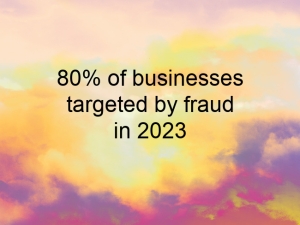By John Gronen, Chief Financial Officer, Yooz
Imagine you’re managing a busy marketplace. Dozens of merchants, hundreds of customers, and money constantly exchanging hands. One day, you notice a small discrepancy in the cash register – nothing too alarming, just a few dollars missing here and there. At first, it seems like a simple error, but over time, these small amounts start adding up, and you realize the problem is much bigger than it appeared. The marketplace is losing money daily, and traditional payment and transaction tracking methods aren’t enough to catch the culprits.
This scenario mirrors what’s happening in today’s business world, particularly in B2B payments. Small, seemingly insignificant fraudulent activities can compound quickly, causing significant financial loss. Traditional fraud detection methods, like manual reviews or static rules, struggle to keep up with the scale and sophistication of modern fraud tactics. This is where artificial intelligence (AI) comes in, offering a real-time, proactive approach to fraud detection that’s changing how businesses in the B2B space protect themselves.
The rising threat of B2B payment fraud

The scope of B2B payments has expanded rapidly with the digitization of finance. According to the 2024 report from the Association for Financial Professionals (AFP), over 80% of organizations reported that they were targeted by payment fraud in 2023, a significant uptick from the previous year. Fraudsters are becoming more sophisticated with phishing attacks, business email compromise, and even infiltrating supply chain transactions to intercept payments.
Traditional fraud detection methods like manual reviews or rules-based systems that flag transactions over a certain threshold are often too slow and rigid to keep up. These methods can be prone to errors, flagging legitimate transactions while allowing some fraudulent ones to slip through the cracks. As businesses scale up and handle more high-volume transactions, the need for more advanced fraud detection tools has risen in direct proportion.
How AI is transforming fraud detection
Artificial intelligence is transforming fraud detection by providing real-time insights and predictive analytics that traditional methods simply can’t match. AI uses machine learning (ML) algorithms to detect patterns in vast datasets and identify anomalies that may indicate fraudulent activity.
Where traditional systems rely on predefined rules – like flagging transactions over a certain amount – AI evolves continuously. It learns from new data, spotting unusual patterns such as changes in transaction frequency, deviations from typical payment routes, or abnormal behavior from trusted partners. For example, AI can detect if a vendor’s banking information changes before processing a payment. This sort of thing would often go unnoticed in a manual review.

AI fraud detection systems like those used by companies such as Mastercard have already proven effective. Mastercard’s AI-driven system reviews and processes over 1.9 billion transactions each year, helping reduce fraud rates while maintaining a smooth customer experience.
The agility AI offers is critical in B2B settings, where high-value transactions, complex account structures, and intricate supply chains increase the risk of sophisticated fraud attempts. AI-driven fraud detection allows B2B organizations to stay ahead by continuously learning from data and catching even the most subtle fraud attempts.
Challenges and limitations of AI in fraud detection
While AI offers several powerful tools that solve modern payment fraud, it has some challenges. For AI systems to perform at their best, they need access to high-quality, comprehensive data. Poor or incomplete data can skew results, leading to missed threats or incorrect conclusions.
The other issue is that fraudsters constantly develop new tactics to evade detection, including adversarial attacks. This is where they manipulate AI systems by feeding them misleading data, which is why AI is most effective when combined with other fraud prevention strategies, such as multi-factor authentication, encryption, and employee training.
Another challenge is ensuring that AI systems are continuously updated and refined. Because fraud is constantly evolving, AI systems need regular training on new datasets to stay effective. AI systems could become outdated without ongoing monitoring and improvements, leaving businesses vulnerable to emerging threats. These tools require a very proactive level of monitoring and updating for businesses using them.
How B2B companies can implement AI for fraud detection

The process doesn’t have to be overwhelming for B2B companies looking to implement AI in their fraud detection systems. Here’s a roadmap to get started.
- Identify vulnerabilities: Begin by mapping out your payment processes to identify where fraud is most likely to occur. That could be during vendor payments, wire transfers, invoice processing, or elsewhere, but the point is you need to understand your risk areas to focus your AI efforts where they matter most.
- Choose the right solution: Many AI-driven fraud detection platforms and tools are available, including off-the-shelf solutions and custom-built ones. Evaluate options based on your transaction volume, complexity, and industry-specific needs. It’s wise to go with a solution that integrates easily with your existing systems.
- Start with a pilot program: Before rolling out AI across all payment systems, consider starting with a pilot program. This allows you to test the system on a smaller scale, tweak its parameters, and gather data on its effectiveness without the risk of widespread disruptions.
- Collaborate with experts: Implementing AI isn’t something most businesses can do on their own. Partner with fintech providers or AI experts who specialize in fraud detection. They can help guide you through the process.
- Monitor and adjust: AI isn’t a set-it-and-forget-it solution. As fraud tactics evolve, so must your AI system. Regularly monitor performance, retrain the algorithms with new data, and adjust parameters to ensure continued effectiveness.
The future of fraud detection in B2B payments
As AI technology advances, it will become an increasingly necessary part of fraud detection in B2B payments. Remember that AI’s benefits in fraud detection extend beyond just security. AI can also automate many aspects of the payment process, reducing manual workloads, improving accuracy, and helping businesses scale more efficiently. For those who start implementing AI now, the future will bring improved security, better compliance, and a significant reduction in fraud-related losses.
In the end, businesses can’t afford to be passive when it comes to payment fraud. AI offers a range of flexible, proactive solutions that can transform how companies protect their transactions and stay ahead of threats, big or small. Now is the time to act before the fraud landscape grows even more complex and losses become irreparable.
About the Author

John Gronen is Chief Financial Officer at Yooz, which provides smart, powerful,
easy-to-use P2P solutions for more than 200 companies in 44 countries.
Recent PaymentsNEXT news:

